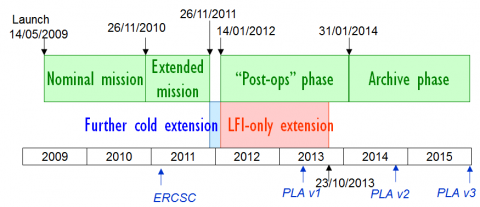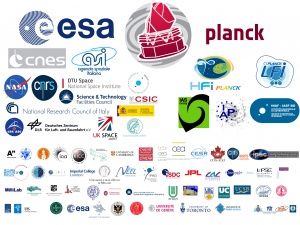Difference between revisions of "The Planck mission WiP"
| Line 71: | Line 71: | ||
carbon fibre technology. | carbon fibre technology. | ||
| − | == Project Timeline == | + | %== Project Timeline == |
The development history of the Planck satellite is summarised [https://www.cosmos.esa.int/web/planck/mission-history here]. | The development history of the Planck satellite is summarised [https://www.cosmos.esa.int/web/planck/mission-history here]. | ||
| Line 78: | Line 78: | ||
The last command to the Planck satellite was sent on the 23 October 2013, marking the end of operations. | The last command to the Planck satellite was sent on the 23 October 2013, marking the end of operations. | ||
| − | [[file:PlanckMissionTimelineV2.png|thumb|480px|Timeline of the Planck operations and archiving.]] | + | |
| + | %[[file:PlanckMissionTimelineV2.png|thumb|480px|Timeline of the Planck operations and archiving.]] | ||
Revision as of 09:15, 5 October 2017
The Planck mission[edit]
Planck is a mission of the European Space Agency - ESA. The Planck satellite carried instruments provided by two scientific Consortia funded by ESA member states (in particular the lead countries: France and Italy) with contributions from NASA (USA), and telescope reflectors provided in a collaboration between ESA and a scientific Consortium led and funded by Denmark.
Planck was conceived in 1992, in the wake of the release of the results from the Cosmic Background Explorer (COBE) satellite, notably the measurement by the FIRAS instrument of the shape of the spectrum of the Cosmic Microwave Background radiation (CMB), and the detection by the DMR instrument of the spatial anisotropies of the temperature of the CMB. The latter result in particular led to an explosion in the number of ground-based and suborbital experiments dedicated to mapping of the anisotropies, and to proposals for space experiments both in Europe and the USA.
The development of Planck began with two proposals presented to the European Space Agency (ESA) in May of 1993, for the Cosmic Background Radiation Anisotropy Satellite (COBRAS) and the Satellite for Measurement of Background Anisotropies (SAMBA, ). Each of these proposed a payload formed by an offset Gregorian telescope focussing light from the sky onto an array of detectors (based on High Electron Mobility Transistor [HEMT] Low Noise Amplifiers for COBRAS and very low temperature bolometers for SAMBA) fed by corrugated horns. The two proposals were used by an ESA-led team to design a payload where a single COBRAS-like telescope fed two instruments, a COBRAS-like Low Frequency Instrument (LFI), and a SAMBA-like High Frequency Instrument (HFI) sharing a common focal plane. A period of study of this concept culminated in the selection by ESA in 1996 of the COBRAS/SAMBA satellite (described in the so-called ``Redbook") into its programme of scientific satellites. At the time of selection the launch of COBRAS/SAMBA was expected to be in 2003. Shortly after the mission was approved, it was renamed in honor of the German scientist Max Planck (1858-1947), winner of the Nobel Prize for Physics in 1918.
Shortly after its selection, the development of Planck was joined with that of ESA's Herschel Space Telescope, based on a number of potential commonalities, the most important of which was that both missions targeted orbits around the second Lagrangian point of the Sun-Earth system and could therefore share a single heavy launcher. In practice the joint development has meant that a single ESA engineering team has led the development of both satellites by a single industrial prime contractor, leading to the use of many identical hardware and software subsystems in both satellites, and a synergistic sharing of engineering skills and manpower. The industrial prime contractor, Thales Alenia Space France, was competitively selected in early 2001. Thales Alenia Space France was supported by two major subcontractors: Thales Alenia Space Italy for the Service Module of both Planck and Herschel, and EADS Astrium GmbH for the Herschel Payload Module, and by many other industrial subcontractors from all ESA member states (industrial team ).
In early 1999, ESA selected two Consortia of scientific institutes to provide the two Planck instruments which were part of the payload described in the Redbook: the Low Frequency Instrument was developed by a consortium led by N. Mandolesi of the Istituto di Astrofisica Spaziale e Fisica Cosmica (CNR) in Bologna (Italy); and the High Frequency Instrument by a consortium led by J.-L. Puget of the Institut d'Astrophysique Spatiale (CNRS) in Orsay (France). More than 40 European institutes, and some from the USA, have collaborated on the development and testing of these instruments, and will continue to carry out their operation, as well as the ensuing data analysis and initial scientific exploitation (see also Appendix A).
In early 2000, ESA and the Danish National Space Institute (DNSI) signed a Letter of Agreement for the provision of the two reflectors that are used in the Planck telescope. DNSI led a Consortium of Danish institutes, which together with ESA subcontracted the development of the Planck reflectors to EADS Astrium GmbH (Friedrichshafen, D), who have manufactured the reflectors using state-of-the-art carbon fibre technology.
%== Project Timeline ==
The development history of the Planck satellite is summarised here. It culminated with its successful launch on 14 May 2009.
The last command to the Planck satellite was sent on the 23 October 2013, marking the end of operations.
%
The Planck Legacy Archive[edit]
Two consortia of scientific institutes
For more information[edit]
A complete overview of the Planck mission and its science programme can be found in the Blue Book.
More details on the Planck mission performance can be found in [1], .
A complete list of Planck publications can be found here.
References[edit]
- ↑ Planck early results. I. The Planck mission, Planck Collaboration I, A&A, 536, A1, (2011).
European Space Agency
Cosmic Microwave background
High Electron Mobility Transistor
(Planck) Low Frequency Instrument
(Planck) High Frequency Instrument

